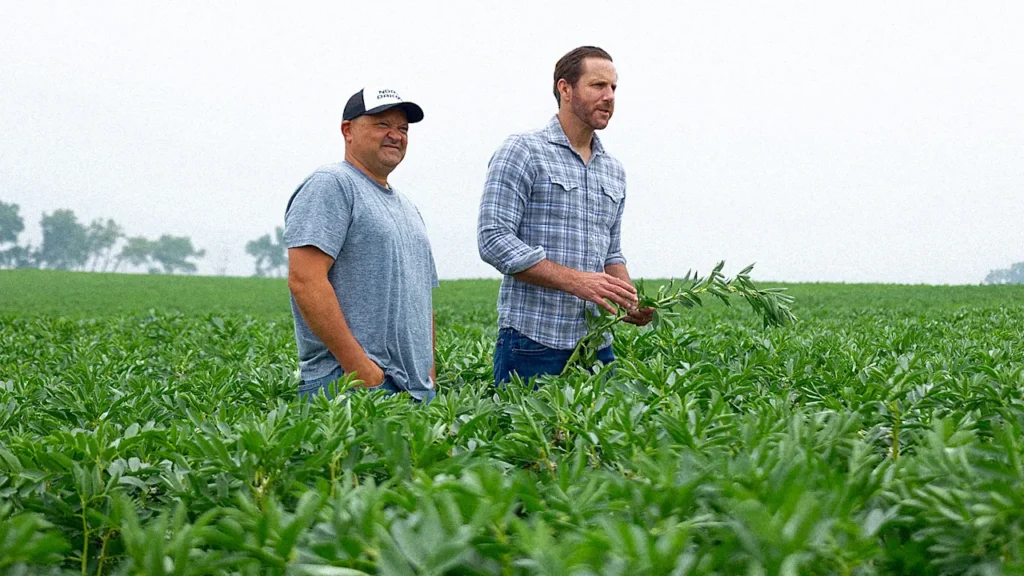
Seated across a table from me at a rented loft near Wall Street in late July, Beyond Meat CEO Ethan Brown is digging into a bowl of Beyond Ground, his company’s latest product, which debuts July 29, goes on sale via the company’s website in August, and promises more protein per serving than beef. But this isn’t just any product demo; it’s a company overhaul.
With this launch, Beyond Meat is becoming merely Beyond and turning its focus away from mimicking animal proteins to letting plant-based proteins speak for themselves. The radical move is cultural, agricultural, and financial, and Brown wasn’t shy in discussing how Beyond now lets the company compete across the grocery store, teasing what products he’s developing, explaining how Silicon Valley money helped shape the public’s ambivalence toward alt meat, and sharing how studying Roman gladiators has influenced Beyond’s new direction.
Brown, who started the company in 2009 and took it public in a celebrated 2019 IPO, is so committed to Beyond’s rebrand and its new product that he has been consuming Beyond Ground’s main ingredient—fava beans—as his primary source of daily calories. “I gotta let my body be my argument,” he says, riffing on a famous quote by physician-philosopher Albert Schweitzer that greets Beyond employees who open the company manual.
In an era when protein is suddenly being stuffed into everything—from chips to waffles to sodas—Brown says he began to wonder: “If you’re the best in the world at making plant proteins, why confine yourself to the center of the plate?”
Without pressure to mimic the exact flavors and textures of beef, chicken, or pork, and without being limited to the center of the plate, or to the dinner table at all, he realized Beyond could get “fanatical” about the plant proteins themselves. “And that will be why people reach for the Beyond brand,” he predicts. Not for “a facsimile,” but “something authentically us.”
The company won’t be sunsetting its existing products anytime soon. And last summer it debuted a line of Sun Sausages that was already a step in the veggie-forward direction.
But now, for the first time in Beyond’s history, it is offering a product that is stripped down to four clean ingredients: the fava beans, potato starch, water, and psyllium husk—fiber from a desert herb prized for its ability to help control cholesterol, blood sugar, and, most crucially, protein absorption. A 1/4-pound serving of Beyond Ground contains 140 calories, 4 grams of fiber, 1.5 grams of fat, zero cholesterol and saturated fat, and no added oils. It has 27 grams of protein, more than a serving of beef.
From Beyond Meat to ‘Beyond’
Beyond Meat launched a new industry in 2009 in order to leverage the magic of science to serve plant proteins that would not only taste like burgers and chicken nuggets, but actually surpass them in health and sustainability. Two years later, Impossible Burger surfaced and became its chief rival, initiating a race to offer vegans and everyone else hoping to eat less meat the most satisfying alternative at cookouts across the country. Their burgers bled, whereas companies before them (Quorn, Gardein, MorningStar Farms) sold vegetable patties that had corn kernels poking out or looked like Spam.
For a decade, the burgers, chicken, ground beef, meatballs, and sausages from these two companies filled grocery meat aisles and restaurant chain menus—first in America, then slowly overseas. But lately sales have fallen, causing a different new period for the category generally and Beyond in particular, as the sole publicly traded player. Worth almost $12 billion following its 2019 IPO, Beyond’s valuation has hovered at or below $500 million since 2023. Impossible Burger has raised close to $2 billion to date; CEO Peter McGuiness told the Wall Street Journal last month that the company is not yet profitable.
Several factors have contributed to the broader sector’s decline—product fatigue, taste expectations going unmet, questions about processed ingredients. Impossible Foods’s McGuinness, who’s taken flak from vegans since warning a month ago that, to drum up more business, “I may do a hybrid burger that’s 50% beef,” believes that the alt-meat industry has done “a lousy job” with outreach, describing their messaging’s premise as equating to “If you ate meat, you were a Neanderthal” and adding: “We were insulting meat eaters.”
But one theory he shares with Brown, and one I previously wrote extensively about for Fast Company, is that two of America’s most powerful industries—meatpackers and the pharmaceutical giants—felt so threatened by the category’s quick rise that they stoked fears about plant-based burgers posing health risks, and it kind of worked. (Big Pharma’s interests boil down to the fact that farm animals receive well over half of all human antibiotics produced.) Attack ads blasting vegan meat products as “ultra-processed imitations,” asking if they differed from dog food, and arguing they contained chemicals that doubled as laxatives went viral as Instagram and TikTok memes.
But Brown also points one finger backwards, partway at least. After grabbing Silicon Valley’s attention, he says the plant-based meat category morphed into “something that was different from its origins.” He says he’s “grateful, because we received a lot of funding,” but Beyond’s raison d’être quickly evolved into more of “a lab thing and a technology thing.”
To develop Beyond Meat’s inaugural product—dubbed Chicken-Free Strips—Brown worked closely with the leading agriculture departments at the University of Missouri and the University of Maryland, two big land-grant universities. He also built rapports with farmers in the Midwest and Saskatchewan. But once the fake chicken started fooling Mark Bittman, investors from Bill Gates to Ev Williams and Biz Stone started doling out money to scale the disruptive technology. “Ultimately,” Brown says, “it diverted consumers’ focus from [the realization that Beyond’s plant-based meat] is closer to the field than the factory-farmed ingredients they’re used to eating.”
The irony is that, despite so much doubt being cast on alt-meat ingredients, the way people eat today is, if anything, more prepackaged and tech-addled than ever. And that’s why Brown believes this moment is just right for Beyond’s redemption arc. He says his epiphany ranks among the most profound discoveries he’s made in life, driving him to invoke Albert Schweitzer yet again, this time the passage Schweitzer wrote in Africa following a freak hippopotamus encounter that led to an “iron door” of understanding opening that showed him the path forward.
The younger crowd might just call it a surge of galaxy-brain clarity. “I thought, What we’re great at is making protein,” he tells me. “So, instead of thinking about a simple replacement for animal protein, what if you just thought about your daily protein consumption, and I started to try to replace as much of that as I can with plant protein, any form that I could?”
Enter the gladiators
Fava beans, Brown says, are just the start. “If you want something that’s a ground product, here you have it,” Brown says. (Beyond says three flavors will join the original variety in August: chipotle pineapple, Korean barbecue, and Tuscan tomato. The main product by itself “is very neutral,” reports Chris Petrellese, who runs Sweet Simple Vegan with his wife, Jasmine Briones and tested an early sample; he made it the star of a casserole and could imagine it being dehydrated into jerky or even blended it into smoothies.)
Going forward, Brown says, the company can “serve an occasion versus trying to mimic an animal…. You’ll see us come out with things like, maybe, lentil sausage. Or chickpea hot dogs.”
Brown hints at a specific new product that he’s labored to develop for a while now but won’t reveal: a packaged good totally unlike Beyond’s previous offerings, destined for grocery store center aisles instead of the meat case. It boasts 30 grams of protein per serving and no fat, and Brown devours the product constantly (calling it “cr-r-r-razy good”).
Beyond is all but certain to pursue a post-workout product, something Brown seems to tease as we worked through our Beyond Ground tasting. He stresses how much reading he’s done lately on Roman gladiators. And then, while rattling off the agronomic virtues of fava beans—how they’re good nitrogen fixers, don’t require fertilizer, and regenerative by default—he lets slide that they also “have this amazing and romantic [link to] gladiators!”
It turns out that bone analysis has revealed that Rome’s elite athletes ate a mostly vegetarian diet—of fava beans, red lentils, and barley. That a decadent, ill-fated society cheered as these powerful warriors fell in the amphitheater surely widens their underdog appeal.
As Brown requests an extra bowl of Beyond Ground to consume by itself during the tasting, I note that he himself fits the part as someone who’s 6-foot-5 and fit. He once told Men’s Health he enjoys bench press because “there’s an element of not being sure you can do it.”
The rise in recent years of fitness culture, wellness marketing, and protein-forward products has propelled a pivot from three square meals a day toward what are often called “intentional eating occasions”—post-workout recovery snacks, meal-replacement shakes, even intentionally not eating (for 18:6, the Warrior Diet, etc.). A whole generation is learning to pick foods based on their function and ratio of “macros,” meaning the strategic tally of fat to carbs to seemingly exponentially more protein, playing to what the New York Times recently called retail’s “protein arms race.”
For Brown, this represents an opportunity to claim new territory. He argues that the crowd craving red meat, collagen keto snacks, and extra-protein milk—maybe with a side of tradwife—is chasing a false nostalgia for a “natural” America that has been undone by industrial agriculture.
In his view, it was a Big Meat/Big Pharma industrial complex that killed the same agrarian ideal people believe they’re tapping into when they purchase a bag of bison liver chips. “There’s a longing for animal protein because we associate it with simpler times,” Brown says. “But how it’s being delivered to us is not [simple].” He is positioning Beyond as far as possible from an agricultural system that has shown itself willing to decimate the land, reengineer the livestock, and market the outcome as something pure and authentic.
Magic beans
As Beyond repositions itself to be an anytime protein source, it’s poised to compete directly against a new generation of recovery snack brands. Market research firm Mintel has said from 2013 to 2024, the number of food and beverage products carrying a high protein label quadrupled. A new survey released by Bain, titled “Peak Protein? Not Even Close,” found that 44% of Americans want to increase their protein intake even further—a 10-point jump from 2024.
Recently valued at $725 million, David—co-created by RXBar’s founder and relentlessly plugged by podcaster Andrew Huberman—has released a new product that is nothing but raw, frozen cod, sold in $50 four-packs, perhaps as a dramatic way of proving how well its popular bars stack up in terms of protein content. The presumed stunt shows how companies are scrambling for consumer attention. Brown is unfazed.
Right now, the protein industry largely consists of one product category created for the clean-eating protein purists who reject “fake food” and carefully scour labels, and a second category for the protein-maxxers who, in a single day, might devour Kodiak Frozen Power Waffles (12 grams of protein), Wilde chicken-breast chips (13 grams), a Bucked Up protein soda (25 grams), and a Fairlife Core Power shake (26 grams). The fewest number of ingredients that any of these products contains is 10—and that’s the soda. The highest number is 28. Among them are gums, gels, and substances such as bovine collagen hydrolysate and acesulfame potassium.
Yet a third group is emerging that wants clean, thoughtful high-protein ingredients of the sort Beyond just relaunched to focus on. The company’s fava beans actually come from one family farm in Munich, North Dakota. Five generations of Zimmers have worked this land. Just last week, Brown stood with them amid their fava rows. He called up a photo for me to see. “That field used to have cattle,” he says, gesturing to the tableau of green now sprouting up in all directions. Then he segues into the wolves, bison, and elk that were wiped from these plains, casualties of an extractive farming style farming that in turn helped trigger the Dust Bowl.
Later, Brown puts it more directly in an email. “We can restore nature,” he writes. “But first we have to give it a chance to live again.”


